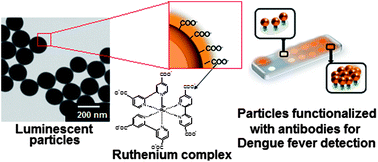Luminescent core–shell particles are structures widely applied to biomedical purposes with the potential of combining multiple features within one single particle. The development of particles that are easily synthesised and tunable for each application, combining biocompatibility, easy bioconjugation and a high detection signal as a label, is highly desired. In this work, we describe a one-step synthesis of poly[styrene-co-(2-hydroxyethyl methacrylate)], PSHEMA, core–shell particles containing [Ru(4,4′-dicarboxilate-2,2′-bpy)3] luminescent complexes. These particles show monodispersity, biocompatibility, easy functionalization and dye incorporation to focus on bioapplications, such as cell-tracking and diagnostics. The monomers assemble during the polymerization and produce core–shell structures with hydrophilic-hydrophobic character. This allows the concentration of hydrophilic ruthenium complexes onto the shell and incorporation of hydrophobic molecules (e.g. diphenylanthracene) due to the hydrophobic character of styrene. The incorporation of the Ru complex resulted in higher photostability compared to the free dye. Furthermore, carboxylic groups on the particle surface originated from carboxylated ligands of Ru complexes were used to immobilize biomolecules. The particles were successfully used as a diagnostic label for dengue fever (DF) infection. Using the complexes in the immunospot assay the test provided a detection limit (DL) of 187 ng mL−1 for the viral non-structural glycoprotein NS1. The particles showed a considerable decrease in the DL and allowed the diagnosis of the infection 24 hours earlier compared to common available assays based on gold nanoparticles. In addition, the particles were tested with an adherent grown fibroblast cell line and showed potential biocompatibility.

You have access to this article
 Please wait while we load your content...
Something went wrong. Try again?
Please wait while we load your content...
Something went wrong. Try again?


 Please wait while we load your content...
Please wait while we load your content...